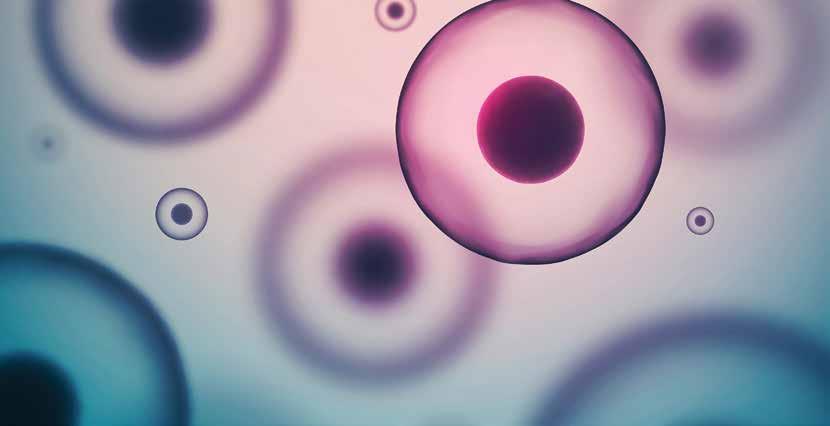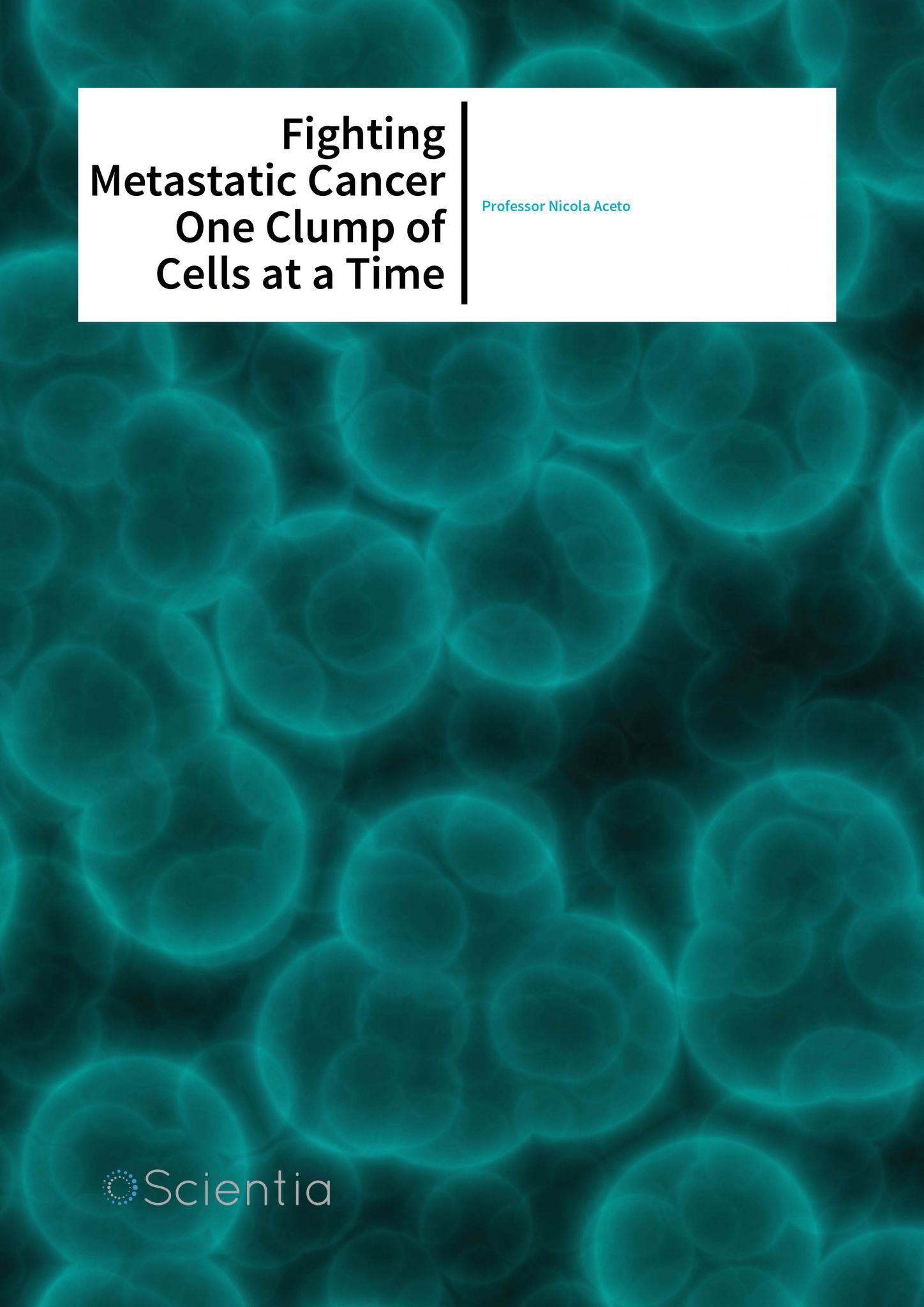Professor Nicola Aceto – Fighting Metastatic Cancer One Clump Of Cells At A Time
Professor Nicola Aceto studies how circulating cancer cell clusters work with an eye on novel treatments for cancer patients with the most deadly disease—metastatic cancer.

How did you come to work at the Cancer Metastasis Lab at the University of Basel, Switzerland? In other words, what got you interested in the topic of cancer metastasis in general—and cancer cell clusters specifically—and how did you come to head the Lab at Basel?
Over 90% of cancer-related deaths are due to the development of a metastatic cancer. This corresponds to more than seven million deaths per year, worldwide. Clearly, we do not know enough about how human cancer spreads, and we do not know how to block the development of metastasis in cancer patients. To dissect the mechanisms that orchestrate metastasis in humans is an extraordinarily important challenge. The solution may greatly impact the life of several million people worldwide affected by this disease. This is why I am interested in this topic. During my postdoctoral training in Daniel Haber’s lab at Harvard, we understood that cancer cell clusters in the blood of cancer patients represent highly dangerous metastatic precursors. This finding highlighted a previously unappreciated aspect of how metastasis occurs. More importantly, it now provides an outstanding opportunity to target these metastatic precursors to block the metastatic process. With this goal in mind, I took the position at the University of Basel in Switzerland. We are embedded within an outstanding academic environment here and collaborate very closely with medical oncologists, as well as experts in genomics, bioinformatics and biomedical engineering worldwide. This environment and collaborative spirit allows us to pursue very ambitious research goals.
You are studying cancer cell clusters and their role in cancer metastasis. Where did the idea of cancer cell clusters come from and why is it important in cancer metastasis?
Cancer cell clusters in the blood of patients with cancer were observed for the first time several decades ago, and often again as an incidental finding during autopsy of cancer patients. Yet, compared to single cancer cells in circulation, these clusters represent a minority, and their isolation has always been dependent upon technological constraints. It is only very recently that microfluidics technology allowed us to isolate and characterize viable cancer cell clusters from the blood of cancer patients, allowing their detailed characterization. Understanding that cancer cell clusters are not only present, but also functionally connected with the development of metastasis, is now a fantastic opportunity to block a main route of cancer dissemination. Further, we have already characterized gene expression of such clusters in patients and are now testing several strategies to eliminate them.
Do you have a plan on translating your laboratory findings about cancer cell clusters and metastases into actual human cancer treatment?
Yes, absolutely. Currently, metastatic cancers are usually treated as a localized tumour. No strategies are available that block the mechanisms that support the spread of cancer cells throughout the body. For this reason, too many patients die because of metastasis and we are very anxious to translate our findings into clinical practice as soon as possible. We are working to identify cellular and subcellular targets that are required for cancer cell clustering. We plan to move rapidly into testing the efficacy of inhibiting such targets in preclinical models and then, with our collaborators, transition into clinical studies with the best candidates.
 How is your cancer cell research funded and what expectations do you have for any self-generated funding?
How is your cancer cell research funded and what expectations do you have for any self-generated funding?
We are grateful to several funding agencies that funded our work. During my time at Harvard, I was awarded funding from the Human Frontier Science Program, the Swiss National Science Foundation, the European Molecular Biology Organization, and the American-Italian Cancer Foundation of New York City. Upon starting the Cancer Metastasis Lab in Basel, we have been awarded a prestigious European Research Council Starting Grant, as well as grants form the Swiss National Science Foundation, the Basel Cancer League, and the L.&Th. La Roche Foundation through the University of Basel. The expectation from our work is that we identify critical mediators of cancer cell clustering to pave the way to the development of new pharmacological agents tailored to suppress the spread of cancer. This is a very ambitious goal, but we are confident it will be feasible in a short time frame given the tools we have available and the knowledge we already developed from the analysis of several patient sample.
What long-range plans do you have for this research and do you intend to focus on other topics in the future?
Ultimately we aim to translate our findings into clinical practice as soon as it can be done. However, from a certain perspective, research on cancer cell clusters has just begun. We now understand their importance in the metastatic process. Yet there are so many open questions to answer about their biology, composition, heterogeneity, and physical properties. Our research is also focused on addressing these questions since their answer may lead to new findings with potential to shape the way we treat patients. What is also important in the long run is that circulating cancer cell analysis may develop into a real-time diagnostic method to show how cancer cells evolve in a patient in response to a given treatment. Further, it may provide a way to predict in individual patients the particular organs that would be in danger for a possible development of metastasis and whether or not a certain therapy will be successful. Our lab is highly interested in these aspects, too, and we have already generated exciting preliminary results in this regard.
FIGHTING AN INVASION BY IDENTIFYING THE INVADERS
To understand how cancers metastasise through the body, Professor Nicola Aceto and his colleagues at the Cancer Metastasis Laboratory of the University of Basel study not just individual tumour cells, but circulating tumour cell clusters, in an effort to understand and fight cancer metastasis
 A Deadly Invasion by Two Routes
A Deadly Invasion by Two Routes
A deadly force arises from a local population. It grows, pushing out or killing the locals and robbing them of their food and resources. When it gets large enough, it sends out individuals disguised as migrants or refugees to other locations where they revert to their true identity and start a new camp, growing and dispossessing the local population. Even worse, larger groups of invaders brazenly band together and travel down major highways to establish satellite camps, wreaking havoc on the native populations wherever they decide to stop.
Who are these malignant invaders? These are cancer cells, spreading from the original tumour as either single cells sneaking through the body via a special disguise, or travelling down major blood vessels in groups bound together by cellular adhesion forces. Either way, either as single circulating tumour cells (CTCs) or circulating tumour cell clusters (CTC clusters), Professor Nicola Aceto and the scientists at the Cancer Metastasis Laboratory in Basel, Switzerland, want to find ways to identify these traveling invaders to enable physicians to more effectively prevent or treat cancer metastases in their patients.
How Cancers Metastasise and Why It’s Important
Actual identification of CTCs was first reported in the Australian Medical Journal in 1869 by Thomas Ashworth. Ashworth found CTC in the blood of a man with metastatic cancer and theorized that cells from a cancerous tumour circulated through the vascular system and caused a new tumour in a distant site. This supported the theory proffered by the British Royal Society award winner Ludwig Virchow as early as 1858, that metastases were caused simply by cancer cells breaking away and embolising through the bloodstream. Then, in 1889 Sir James Paget published his observations in The Lancet, that there were higher rates of metastases to bone and ovary in women who had died of cancer. Paget reasoned that metastases were not just a random seeding of distant tissue by tumour cells, but that the tumour cells had to somehow be compatible with the target tissue before a metastasis could take root. The subsequent “seed versus soil” debate—whether cancer cells simply embolised where they willed or whether particular distant organs were providing a more favourable environment than others—has persisted since. But is that important? And why is it important even to know much about metastases other than that they exist?
Cancer is a scary word and a terrifying condition to have. But many cancers, especially when found early, are eminently curable. But when there are metastases, the odds are much worse. Cancer that has spread to distant organs, usually resulting in a label of “stage IV”, reduces survival rates dramatically. For example, stage I breast cancer—cancer confined to the breast—has a survival rate at five years of about 99%, according to Cancer Research UK. The American Cancer Society quotes 100%. However, for stage IV breast cancer—breast cancer that has spread to distant organs—the survival rate is 15% according to CR-UK, 22% according to the ACS. The difference is obviously remarkable . . . and disturbing. Aceto and like-minded scientists believe that we need to learn all we can about the process of cancer metastasis to find better ways of preventing or treating deadly metastatic cancer.
 Finding CTC Clusters In Live Patients
Finding CTC Clusters In Live Patients
Finding CTC Clusters In Live Patients Current research by Aceto and others have determined that CTCs spread through the body both ways, as individual CTCs and as CTC clusters. Individual CTCs are thought to travel through the body in disguise, so to speak. Individual cells of epithelial cancers, like breast cancer for example, can transition into mesenchymal-like cells—cells that usually make up connective tissue—and then transition back to their native epithelial cell type after they wander through the body and arrive at a suitable destination. There, they proliferate into a new tumour if conditions are right. The problem with individual CTCs is, individual cells are easier for the body to eliminate, if they survive at all.
On the other hand, CTC clusters—groups of cancer cells bound together by intercellular adhesive molecules—are more resistant to the body’s defences, giving them more metastatic potential than individual CTCs. In other words, CTC clusters are the most dangerous type of metastatic cells. This is why Aceto and his colleagues are especially focused on CTC clusters and how to find and destroy them.
In terms of identifying CTC clusters, Aceto and collaborators have isolated CTC clusters in the blood patients with metastatic breast cancer, prostate cancer and melanoma with newly developed specialized technologies. Their results were published in Cell, Science and Nature Methods during the past two years. The ability to actually detect CTC clusters in cancer patients may be very useful to stratify patients that might have more severe disease. It also could identify patients who might benefit from cell-cell junction therapy, a new strategy Aceto is pursuing specific to CTC clusters.
Aceto has done molecular analysis of human CTC clusters and found that these metastatic precursors rely upon the expression of specific cell-cell junction components such as plakoglobin and other cell-cell junction markers. In other words, certain junction molecules keep the cells in CTC clusters stuck together. These molecules—cell adhesion molecules—are similar to the molecules that keep adjacent normal cells together in a tissue. The strategy would be to find specific pharmacologic agents—drugs—that would attack junction molecules in CTC clusters without harming similar molecules in normal tissues. This would theoretically break up the CTC clusters, making them vulnerable to the body’s own defences and other therapies. Additionally the ability to isolate CTC clusters from individual patients and analyse them could lead to individualized patient-specific therapy, therapy to use in combination with cell-cell junction therapy, depending on the characteristics of that specific patient’s CTC clusters.
Looking Toward The Future
This is Aceto’s dream outcome—to achieve a therapy that suppresses metastasis by targeting CTC clusters in live patients. According to mouse models, such therapy could have a phenomenal impact in reducing the spread of cancer. A lot of work still needs to be done in this direction, including the identification of the best therapeutic targets in the CTC clusters. What will be needed is to find those molecular targets that are required for cancer cell clustering, but not required for cellto- cell attachment of healthy cells within the body. Once these targets will be identified, the dream outcome is to implement a therapy and to readily test it in patients, aiming at the suppression of their metastatic disease.
Beyond a therapy to suppress cancer cell clusters, the analysis of circulating cancer cells holds the extraordinary potential to dissect the molecular drivers of cancer metastasis, and to achieve precision medicine for each patient in real time. Future studies will be key to transform the potential of circulating cancer cell analysis into clinical practice.
Meet the researcher

Professor Nicola Aceto
Group Leader, Cancer Metastasis Laboratory
Department of Biomedicine, University of Basel, Switzerland
Professor Nicola Aceto received his Bachelor of Biotechnology and Masters in Medical and Pharmaceutical Biotechnology from the University Amedeo Avogadro in Novara, Italy. He received his PhD in 2011 from the Friedrich Miescher Institute in Basel, Switzerland. He was a postdoctoral fellow in the Haber Laboratory at Harvard Medical School and Massachusetts General Hospital Cancer Centre in Boston, Massachusetts. He has also been an active member of the Broad Institute of MIT and Harvard in Cambridge, Massachusetts, and a visiting scientist in the Clevers Laboratory at the Hubrecht Institute in the Netherlands. Professor Aceto has authored several peer-reviewed publications in leading journals in the cancer field, including Cell, Science, Nature Medicine and Nature Methods, and he is an inventor on four patents related to the diagnosis and treatment of cancer. He has been an invited speaker at a number of congresses, academic and industrial organisations that are leaders in the life sciences field.
CONTACT
T: +41 61 267 0773
W: http://www.cancermetastasislab.com
KEY COLLABORATORS
Christoph Rochlitz, University Hospital Basel
Alfred Zippelius, University Hospital Basel
Walter Weber, University Hospital Basel
Marcus Vetter, University Hospital Basel
Christian Beisel, ETH Zurich
Niko Beerenwinkel, ETH Zurich
Fatih Sarioglu, Georgia Institute of Technology
Gerhard Christofori, University of Basel
Shyamala Maheswaran, Harvard Medical School
Daniel Haber, Harvard Medical School
Sofia Gkountela, Cancer Metastasis Laboratory, University of Basel
Cinzia Donato, Cancer Metastasis Laboratory, University of Basel
Barbara Maria Szczerba, Cancer Metastasis Laboratory, University of Basel
Ilona Krol, Cancer Metastasis Laboratory, University of Basel,
FUNDING
ERC
Swiss National Science Foundation
The Basel Cancer League
University of Basel

